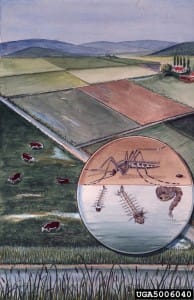Elmer Gray, UGA Extension Entomologist
As we move into the last weeks of summer, be aware of the excellent conditions for mosquito development that this summer’s heavy rains have created. This year has been very different from recent years when we consider our local rainfall totals. To date, much of the state is 15 inches or more ahead of normal rainfall for this time of the year. As a result there is more standing water in our counties and communities than in recent memory. This standing water will provide excellent larval habitat for mosquitoes as we move into the last few weeks of summer.
Mosquitoes are semi-aquatic insects that require standing water for the larval and pupal stages. There are 63 species of mosquitoes

known in Georgia and as result they exhibit a range of life histories.
Typically, the female mosquito will lay eggs on the surface of the water, attached to the sides of a container just above the water’s surface or on moist soil that will become covered with water at a later date. After being covered with water and in due time, the eggs hatch and the larvae (or “wigglers” as they are commonly called) develop in the standing water. The larvae are filter feeders, feeding on small particles of plant and animal matter.
After developing through 4 instars the larvae progress to the pupal stage which is commonly called a “tumbler” due to their movement through the water. Both the larvae and pupae come to the water’s surface for air and move down into the water when disturbed. After 2-3 days in the pupal stage the adult mosquito that we are all familiar with will emerge onto the water’s surface.
In the late summer, this cycle can be completed in as little as 7 days. This summer, with the numerous cloudy days and relatively cool temperatures, this cycle has surely been extended. The cool night temperatures have probably been the only thing preventing even worse mosquito populations than we have already experienced.
Homeowners can often reduce mosquito populations around their homes and neighborhoods by being diligent. All standing water should be eliminated or treated with an EPA approved larvicide if mosquito larvae are present. Emptying buckets, plant saucers, boats, tarps and anything else that can hold water is extremely helpful. Keeping gutter’s clear of leaves and debris will help to eliminate the often neglected larval habitat of backed up gutters. Homeowners should also check those rain barrels that were so helpful in past year’s droughts. It is vital that screens are intact around all openings or these barrels will become highly productive mosquito habitats. In addition, screens on the windows and doors should be checked to make sure there are no holes. Many mosquitoes are attracted to light and will be drawn to open windows after dark when we’re trying to get some fresh air in our homes.
As of August 22, the Georgia Department of Public Health has only reported 2 human cases of West Nile virus (WNV) in Georgia. This low number of cases is in contrast to last year when Georgia experienced a record 117 cases of WNV with 6 deaths. The WNV is now known to occur across the state and has been isolated from mosquitoes in the four counties (Chatham, DeKalb, Glynn and Lowndes) where adult mosquito surveillance and testing are being conducted this year.
The low number of human WNV cases is likely related to the fact that the mosquito (the Southern House Mosquito) that transmits the disease often develops in the storm drain system, particularly during dry periods. With this year’s heavy and regular rainfall, the storm drain systems across the state are regularly flushed and populations of this mosquito have been somewhat suppressed. However, we don’t want people to let down their guard as football season arrives. The peak period for WNV transmission in Georgia has historically been August 15-September 15. The proper use of EPA approved repellents is highly recommended if people are expecting to encounter mosquito populations in the next few weeks.
Products containing DEET are recommended for use on children as young as two months by the American Academy of Pediatrics. Parents should apply the repellent to their hands and then apply it to the children. It is important to get good coverage and then wash the treated skin upon returning indoors.
In conclusion, mosquito control districts across the state are reporting high numbers of complaints due to a variety of species of mosquitoes that have benefited from the abundant rainfall. Health districts across south Georgia are also seeing an increase in Eastern Equine Encephalitis (EEE) in horses. This disease is caused by a virus that is transmitted by mosquitoes that typically develop in the swamps and woodlands below the fall line in Georgia. While cases are rare in humans, EEE symptoms range from mild flu-like illness to encephalitis (inflammation of the brain), coma and possibly death. Symptomatic cases have a fatality rate of 30-50% and it is classified as the most severe mosquito-borne disease of humans in the United States.
Preventing mosquito bites is crucial to avoiding any of the mosquito-borne diseases. Loose fitting, light colored clothing, coupled with the proper use of EPA labeled repellents, will go a long ways towards this goal by making us less attractive to mosquitoes.
For more information